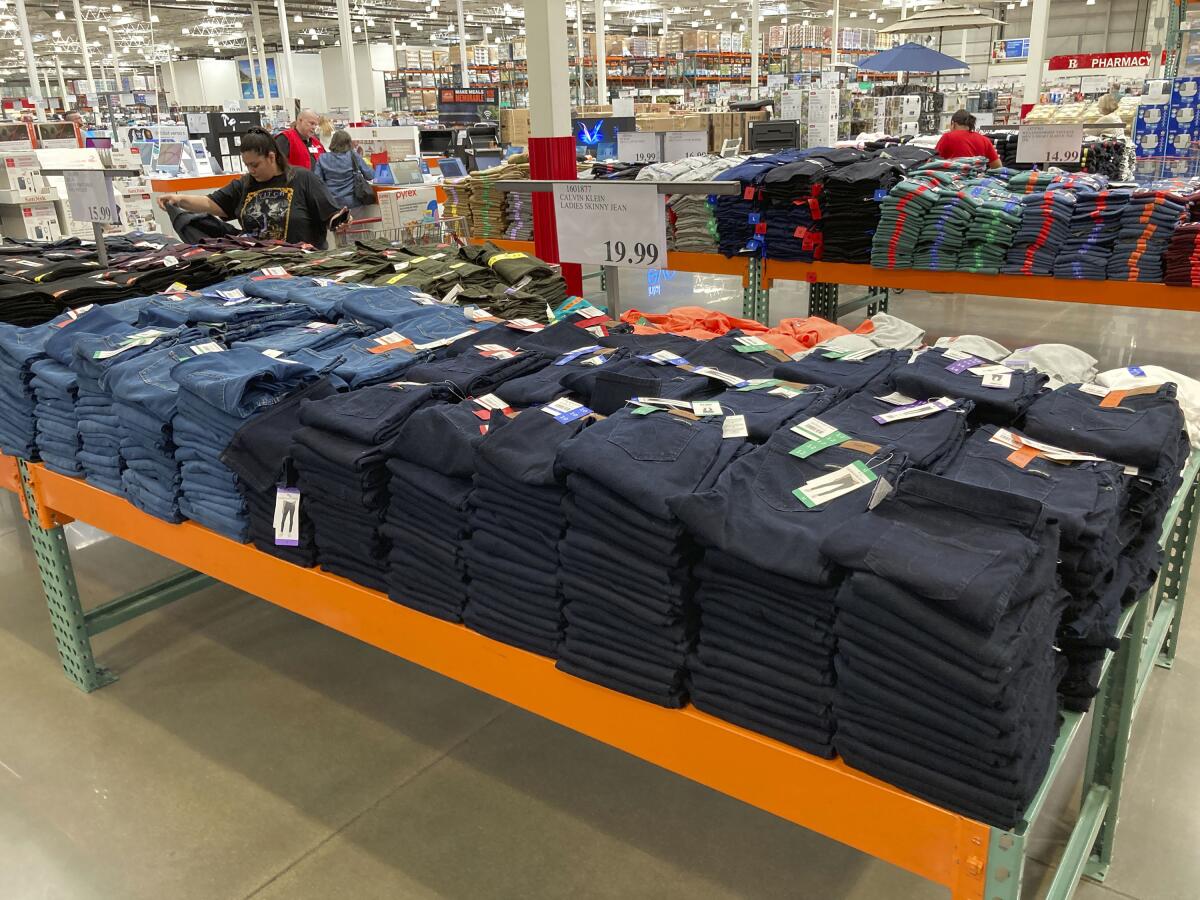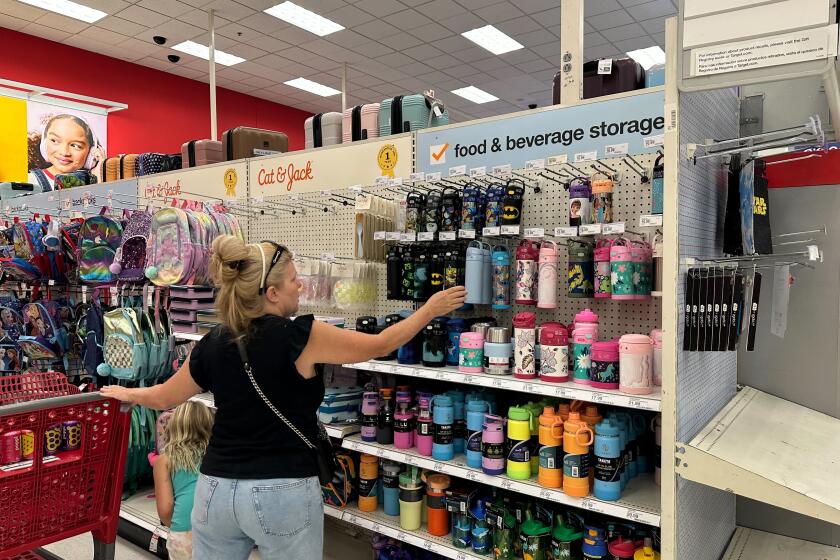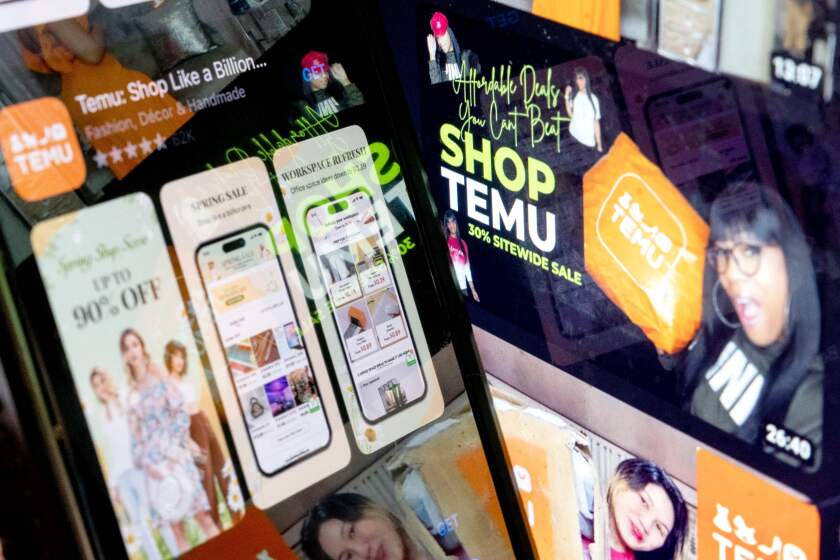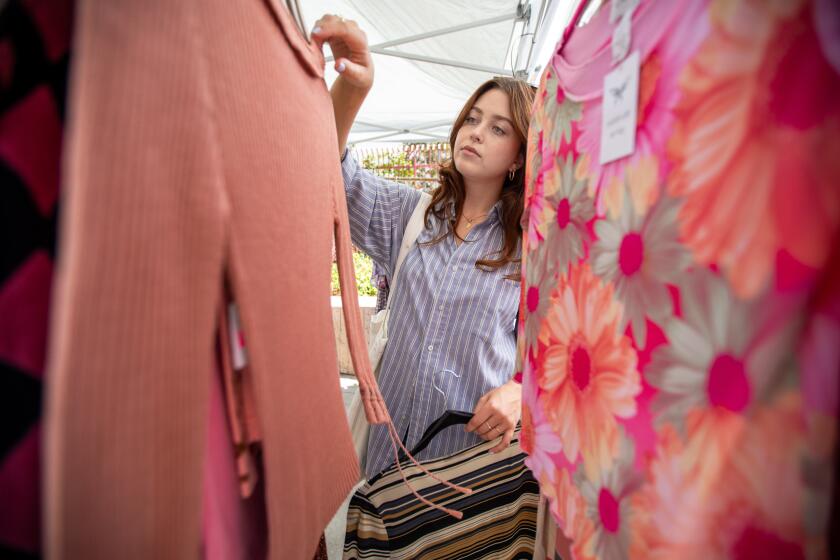Thinking of buying a new pair of jeans? Breaking down the cost over time might help you decide

- Share via
For Jake Welch, getting dressed is one big math problem.
The 36-year-old brand director for an advertising firm calculates the cost-per-wear of his wardrobe by highlighting 200 items in a spreadsheet — excluding underwear and socks — and meticulously listing the price he paid for each of them as well as how many times he’s worn it. He updates the spreadsheet every night on his computer to determine whether his purchases were worth it — or not.
Lots of people thought Welch was weird when he started doing this 12 years ago, opting to ditch the cheapest items on the sales rack in favor of maximizing the value of his purchases over the span of their lifecycles. But with inflation still a nagging problem, more shoppers are coming around to his way of thinking.

“I was actually onto something versus being a little looney,” said Welch of Erda, Utah, who presented his findings last month at a company meeting.
Retailers are taking note of this mindset and shifting their marketing strategy in some cases.
Gap’s Old Navy is offering shoppers a full refund for uniforms purchased during the upcoming back-to-school season if the clothes don’t hold up for a year. Retailers including Kohl’s and online shirt retailer Untuckit have recently revamped their marketing campaigns — particularly for the fall — to focus on durability and versatility. American Eagle is touting the “longevity of your most-loved jeans” made of recycled cotton and polyester in an email campaigns to customers.
As back-to-school shopping is forecast to reach a record $41.5 billion this year, parents and teachers in L.A. debate what’s essential on their lists — and get creative to make ends meet.
That means a $200 classic sweater may end up being a better deal if you plan to wear it every week in comparison to a hot pink dress picked up for $40 that might be worn only once a month.
“Cost-per-wear is another way that they think about how to combat some of the inflation,” said Christie Raymond, Kohl’s chief marketing officer. “Is this item going to last? Is it going to really be versatile? For back to school, for example, can my child wear it in a number of different ways?”
Some shoppers are also looking to be more eco-friendly by buying clothes that don’t end up in a landfill after being worn a few times.
Still, the cost-per-wear calculation may make sense only for those consumers who can afford to prioritize quality and versatility over price. Neil Saunders, managing director of GlobalData Retail, notes that shoppers with tighter budgets will look at price and may not care whether something will last just as long as it looks good for now.
Indeed, fast-fashion purveyors are still faring well in the face of inflation.
Chinese e-commerce retailer Temu, known for deep discounts and coupons, has continued its meteoric rise in the U.S., adding nearly 10 million new daily users since the turn of the year, according to market intelligence firm GWS. Meanwhile, Shein, the ultra-low-price, fast-fashion juggernaut founded in China, has been increasing its daily users to 4.9 million daily users over the past year, from 3.1 million a year earlier, according to GWS.
Chinese shopping app Temu is now the most downloaded app in the United States. But it’s raising red flags for lawmakers who are suspicious of Chinese-owned apps that collect reams of American consumer data.
But there’s a growing backlash to the cheap stuff.
Rohan Deuskar, chief executive of Stylitics, a retail technology firm that powers personalized styling, outfitting and bundling suggestions for 150 retailers online, said he started seeing the trend this past holiday shopping season. He noted the average order was going up, particularly for holiday dresses, while shoppers were buying fewer items. And shoppers were also spending more time engaging with the virtual models that showed different ways to wear the item.
“Shoppers are being more considerate about every purchase and being willing to spend only if they get value — and that no longer just means cheap,“ Deuskar said. ”We’re reaching a little bit of an oversaturation of buying a bunch of stuff. ”
Higher prices are outpacing lower prices over the past 12-month period ending in June, according to market research firm Circana’s Retail Tracking Service. Women’s dresses priced $200 and above grew about twice as fast as those priced under $50. Sales of men’s jeans that were less than $30 declined, while higher price brands drove growth. Sales of women’s jeans priced $150 and above increased by 7%. And while the market for women’s active pants declined 20%, women’s active pants priced between $125 to $150 increased 19%, according to Circana.
Saunders notes that “price and quality aren’t always linked.” In fact, some retailers may be using any excuse to sell higher price goods. There’s also the timeliness of the fashion item to consider. Shoppers may think about longevity when they look for a coat but not for a skirt or a top.
“People like to refresh or their tastes change,” he said.
A wedding ceremony — loaner dress and suit included — for about $600? A beach elopement for $399? Meet the couples choosing tiny, affordable nuptials.
And cost-per-wear calculations don’t factor in weight loss or gain, Saunders added.
Welch said his wardrobe consists of mostly blacks, grays and blues and items that can carry through multiple seasons. Higher inflation has helped him better separate his needs and wants.
“I ask myself a little bit harder: ‘Is it something that I absolutely need?’” he said. “Consulting my spreadsheet, how many golf shorts do I really have?”
Welch noted that his formalwear and suits along with dress shirts are among the items that rank the highest in cost-per-wear. He chose a charcoal suit — not a tan version — for his wedding in 2018 that he bought for $480 at Bonobos. He has worn it 44 times, resulting in a cost-per-wear of $10.91. Not too bad, but ideally he likes to get it down to 50 cents per wear, like the athletic shorts he bought at Outdoor Voices for $20 and has worn 434 times, according to his spreadsheet he shared.
Kohl’s said its marketing campaigns are showing different ways that items can be worn. For example, on the department store’s Instagram account, it pairs a white T-shirt and denim shirts in different ways, including a beachy take and a more stylish approach with hoop earrings. Untuckit’s fall campaign, “Made for the next journey,” focuses on the different ways customers can wear the shirt or the jacket — taking it from the office to nighttime events.
Any stigma of buying fashion secondhand is gone. Shoppers are running mini resale businesses as the investment value of certain luxury brands has soared.
As for Welch, he said his wife is now staying away from fast-fashion and focusing on quality, though she’s not embracing the spreadsheets. And he’s delighted that his two girls, ages 3 and 7 months, fit with the new math.
“With my first daughter, the cost for use on her dresses and stuff like that have decreased with having another girl, ” he said. “So if we have a boy, great. But if we have another girl, that’s just even more savings.”
More to Read
Inside the business of entertainment
The Wide Shot brings you news, analysis and insights on everything from streaming wars to production — and what it all means for the future.
You may occasionally receive promotional content from the Los Angeles Times.














